1997 BUICK REGAL flat tire
[x] Cancel search: flat tirePage 317 of 422

How to Check
Use a good quality pocket-type gage to check tire
pressure. You can’t tell if your tires are properly inflated
simply by looking at them. Radial tires may
look
properly inflated even when they’re underinflated.
Be sure
to put the valve caps back on the valve stems.
They help prevent leaks by keeping out dirt and moisture.
Tire Inspection and Rotation
Tires should be rotated every 6,000 to 8,000 miles
(10 000 to 13 000 km). Any time you notice unusual
wear, rotate your tires as soon as possible and check
wheel alignment. Also check for damaged tires or
wheels. See “When It’s Time for New Tires” and
“Wheel Replacement” later in this section for
more information.
The purpose of regular rotation is to achieve more
uniform wear for
all tires on the vehicle. The first
rotation is the most important. See “Scheduled
Maintenance Services” in the Index for scheduled
rotation intervals. When
rotating your tires, always use the correct rotation
pattern shown here.
Don’t include the compact spare tire in your tire rotation.
After the tires have been rotated, adjust
the front and
rear inflation pressures as shown on the Tire-Loading
Information label. Make certain that all wheel nuts are
properly tightened. See “Wheel Nut Torque” in the Index.
ProCarManuals.com
Page 318 of 422
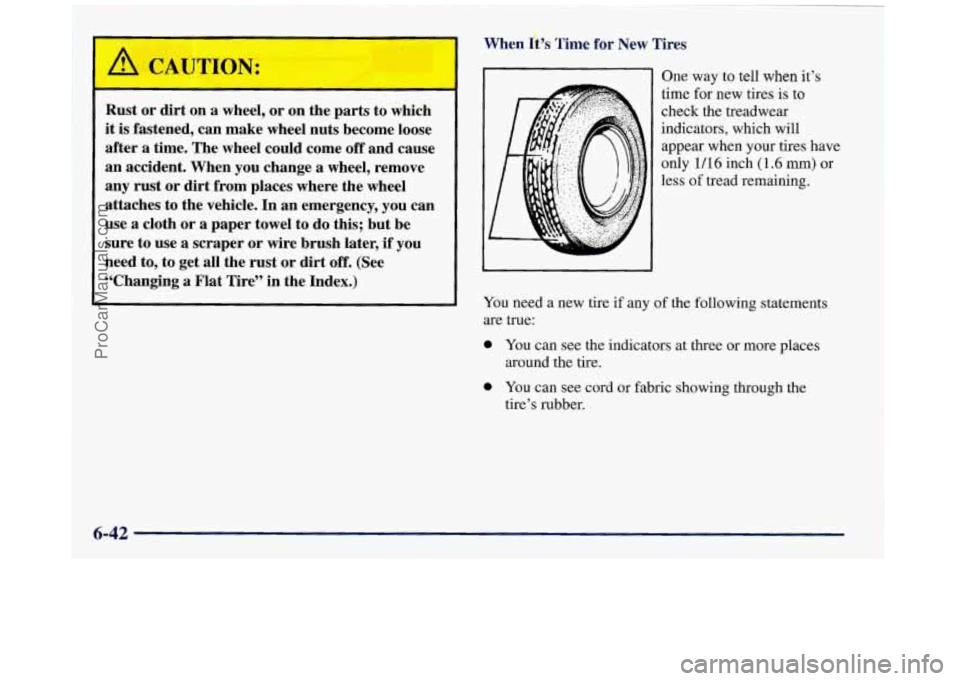
When &)s The for New Tires
Rust or dirt on a wheel, or on the parts to which
it is fastened, can make wheel nuts become loose
after a time. The wheel could come
off and cause
an accident. When you change
a wheel, remove
any rust or dirt from places where the wheel
attaches to the vehicle. In an emergency, you can
use
a cloth or a paper towel to do this; but be
sure to use a scraper or wire brush later,
if you
need to, to get all the rust or
dirt off. (See
“Changing
a Flat Tire” in the Index.)
One way to tell’when it’s
time for new tires is to
check the treadwear
indicators, which will
appear when your tires have
only 1/16 inch (1.6
mm) or
less of tread remaining.
You need a new tire if any of the following statements
are true:
0 You can see the indicators at three or more places
around the tire.
0 You can see cord or fabric showing through the
tire’s rubber.
6-42
ProCarManuals.com
Page 321 of 422
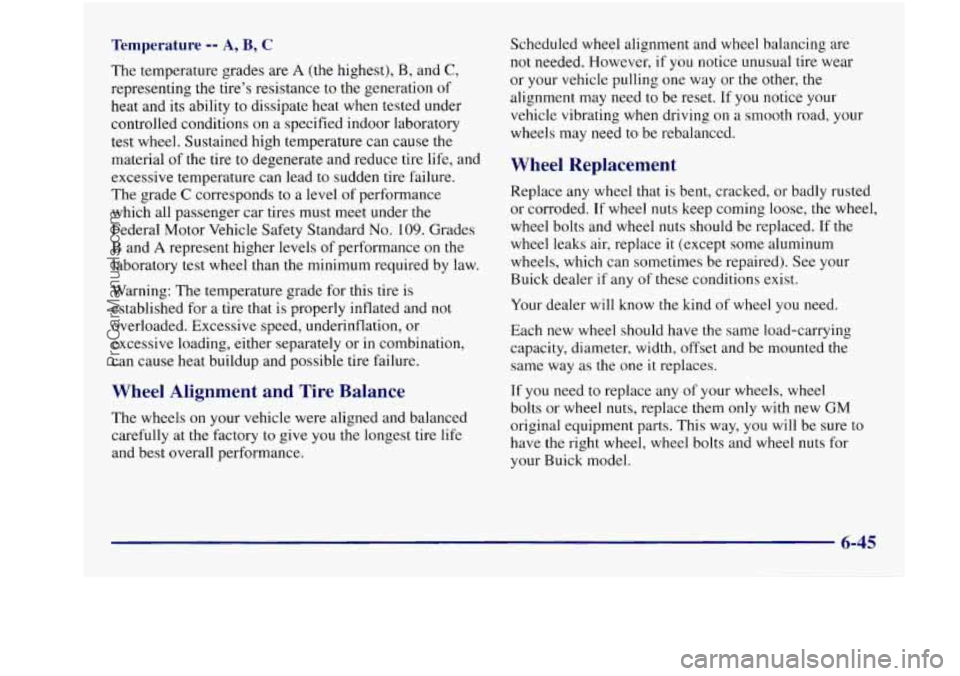
Temperature -- A, B, C
The temperature grades are A (the highest), B, and C,
representing the tire’s resistance to the generation of
heat and its ability to dissipate heat when tested under
controlled conditions on a specified indoor laboratory
test wheel. Sustained high temperature can cause the
material
of the tire to degenerate and reduce tire life, and
excessive temperature can lead to sudden tire failure.
The grade
C corresponds to a level of performance
which all passenger car tires must meet under the
Federal Motor Vehicle Safety Standard
No. 109. Grades
B and
A represent higher levels of performance on the
laboratory test wheel than the minimum required by law.
Warning: The temperature grade for this tire is
established for a tire that is properly inflated and not
overloaded. Excessive speed, underinflation, or
excessive loading, either separately or in combination,
can cause heat buildup and possible tire failure.
Wheel Alignment and Tire Balance
The wheels on your vehicle were aligned and balanced
carefully at the factory to give
you the longest tire life
and best overall performance. Scheduled
wheel alignment and wheel balancing are
not needed. However,
if you notice unusual tire wear
or your vehicle pulling one way or the other, the
alignment
may need to be reset. If you notice your
vehicle vibrating when driving on
a smooth road, your
wheels may need to be rebalanced.
Wheel Replacement
Replace any wheel that is bent, cracked, or badly rusted
or corroded.
If wheel nuts keep coming loose, the wheel,
wheel bolts and wheel nuts should be replaced.
If the
wheel leaks air, replace it (except some aluminum
wheels, which can sometimes be repaired). See your
Buick dealer
if any of these conditions exist.
Your dealer will know the kind of wheel you need.
Each new wheel should have the same load-carrying
capacity, diameter, width, offset and be mounted the
same way as the one it replaces.
If you need to replace any of your wheels, wheel
bolts or wheel nuts, replace them only with new GM
original equipment parts. This way, you will be sure to
have the right wheel, wheel bolts and wheel nuts for
your Buick model.
6-45
ProCarManuals.com
Page 322 of 422
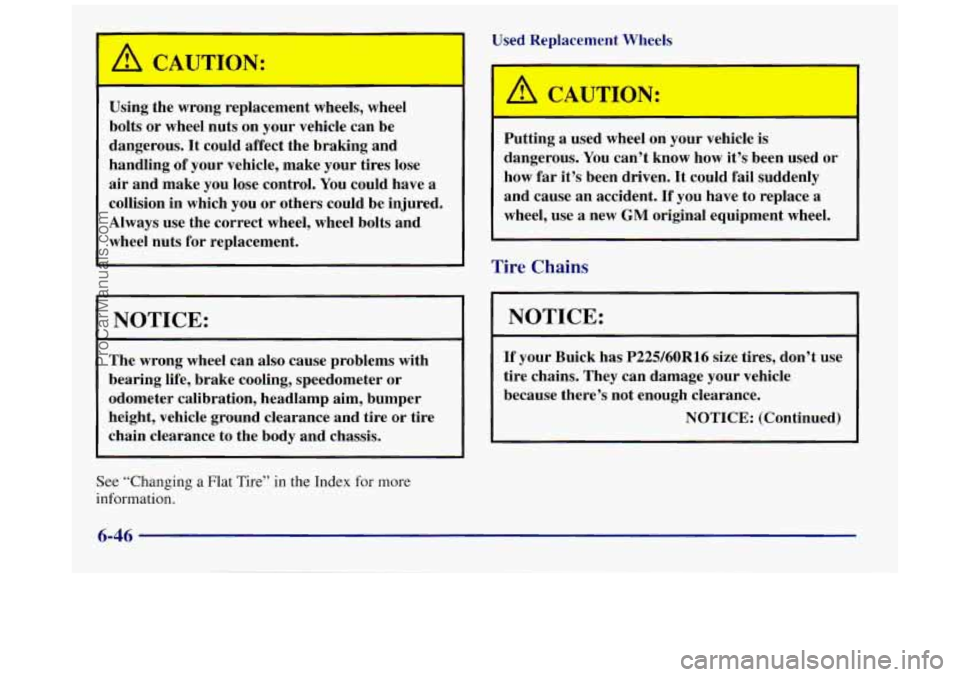
1 Used Replacement Wheels
Using the wrong replacement wheels, wheel
bolts or wheel nuts on your vehicle can be
dangerous. It could affect the braking and
handling
of your vehicle, make your tires lose
air and make you lose control. You could have
a
collision in which you or others could be injured.
Always use the correct wheel, wheel bolts and
wheel nuts for replacement.
NOTICE:
The wrong wheel can also cause problems with
bearing life, brake cooling, speedometer or
odometer calibration, headlamp aim, bumper height, vehicle ground clearance and tire or tire
chain clearance
to the body and chassis.
See “Changing a Flat Tire”
in the Index for more
information. Putting
a used wheel
on your vehicle is
dangerous. You can’t know how it’s been used or
how far it’s been driven. It could fail suddenly
and cause an accident.
If you have to replace a
wheel, use a new
GM original equipment wheel.
Tire Chains
NOTICE:
If your Buick has P225/60R16 size tires, don’t use
tire chains. They can damage your vehicle
because there’s not enough clearance.
NOTICE: (Continued)
6-46
ProCarManuals.com
Page 335 of 422
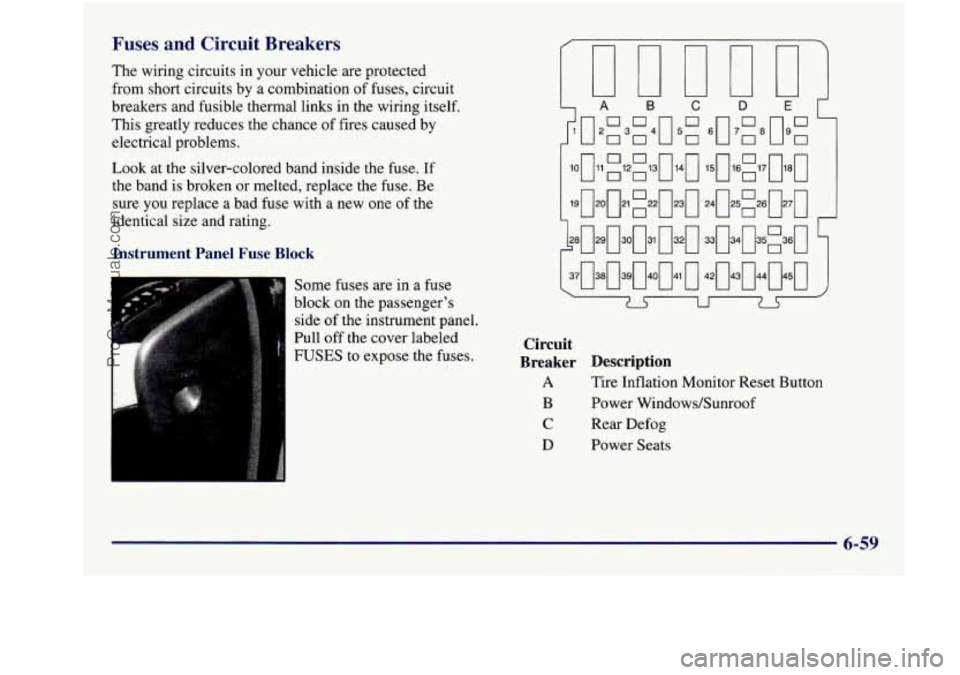
Fuses and Circuit Breakers
The wiring circuits in your vehicle are protected
from short circuits by a combination of fuses, circuit
breakers and fusible thermal links in the wiring itself.
This greatly reduces the chance
of fires caused by
electrical problems.
Look at the silver-colored band inside the fuse. If
the band is broken or melted, replace the fuse. Be
sure you replace a bad fuse with a new one
of the
identical size and rating.
Instrument Panel Fuse Block
Some fuses are in a fuse
block on the passenger’s
side of the instrument panel.
Pull off the cover labeled
FUSES to expose the fuses.
B C D
Circuit
Breaker Description
A Tire Inflation Monitor Reset Button
B Power Windows/Sunroof
C Rear Defog
D Power Seats
6-59
ProCarManuals.com
Page 344 of 422
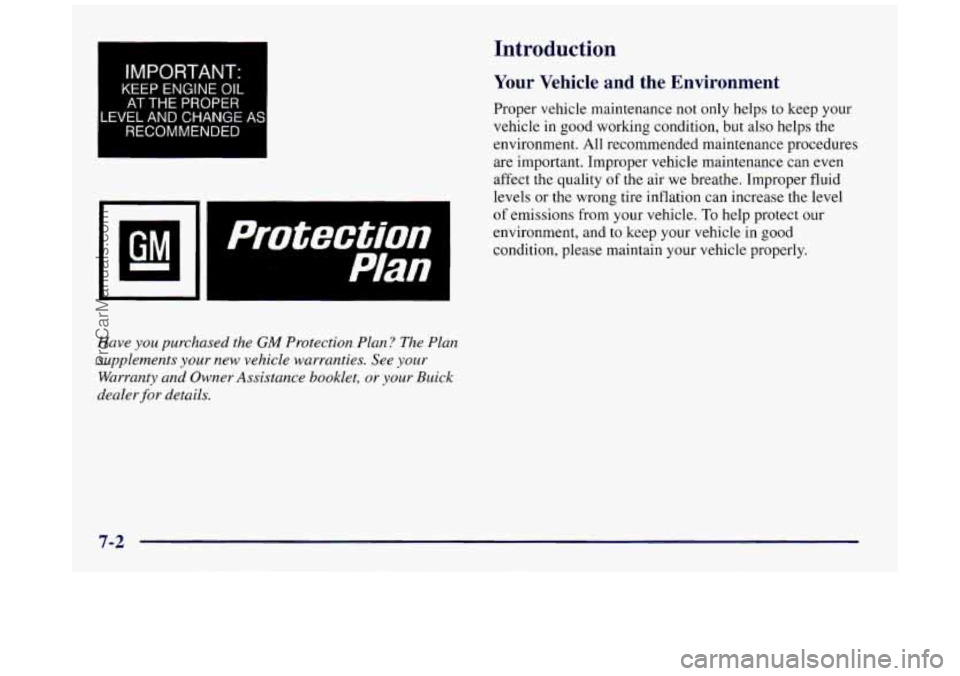
Introduction
IMPORTANT:
KEEP ENGINE OIL
AT THE PROPER
IVEL AND CHANGE
RECOMMENDED
Have you purchased the GM Protection Plan? The Plan
supplements
your new vehicle warranties. See your
Warranty and Owner Assistance booklet, or your Buick
dealer
for details.
Your Vehicle and the Environment
Proper vehicle maintenance not only helps to keep your
vehicle in good working condition, but also helps the
environment. All recommended maintenance procedures
are important. Improper vehicle maintenance can even
affect the quality of the air we breathe. Improper fluid
levels or the wrong tire inflation can increase the level
of emissions from your vehicle.
To help protect our
environment, and to keep your vehicle in good
condition, please maintain your vehicle properly.
7-2
ProCarManuals.com
Page 381 of 422
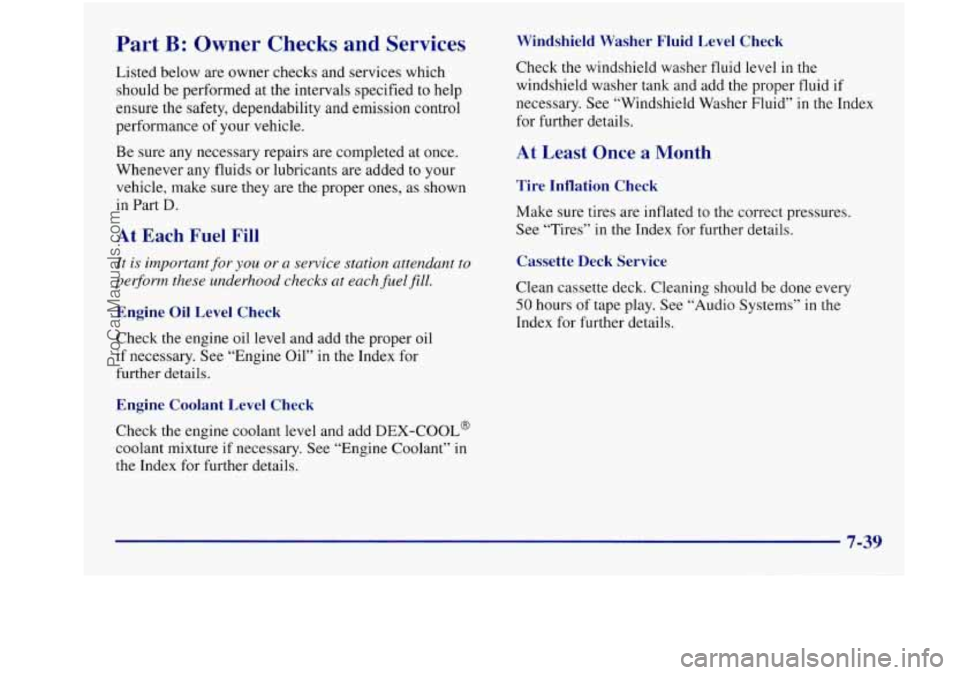
Part B: Owner Checks and Services
Listed below are owner checks and services which
should be performed at the intervals specified to help
ensure the safety, dependability and emission control
performance
of your vehicle.
Be sure any necessary repairs are completed at once.
Whenever any fluids or lubricants are added to your
vehicle, make sure they are the proper ones, as shown
in Part
D.
At Each Fuel Fill
It is important for you or a service station attendant to
pegown these underhood checks at each
fuel fill.
Engine Oil Level Check
Check the engine oil level and add the proper oil
if necessary. See “Engine Oil” in the Index for
further details.
Engine Coolant Level Check
Check the engine coolant level and add DEX-COOL@
coolant mixture if necessary. See “Engine Coolant” in
the Index for further details.
Windshield washer Fluid Level Check
Check the windshield washer fluid level in the
windshield washer tank and add the proper fluid if
necessary.
See “Windshield Washer Fluid” in the Index
for further details.
At Least Once a Month
Tire Inflation Check
Make sure tires are inflated to the correct pressures.
See “Tires” in the Index for further details.
Cassette Deck Service
Clean cassette deck. Cleaning should be done every
50 hours of tape play. See “Audio Systems” in the
Index for further details.
7-39
ProCarManuals.com
Page 407 of 422
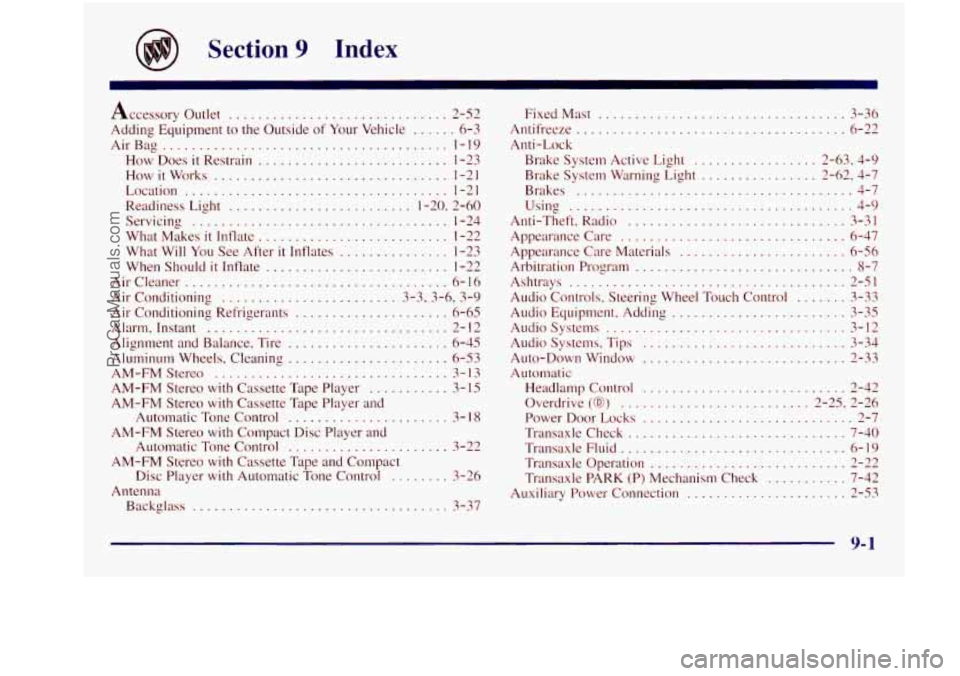
Section 9 Index
Accessory outlet .............................. 2-52
Adding Equipment to the Outside
of Your Vehicle ...... 6-3
AirBag
....................................... 1-19
How Does it Restrain .......................... 1-23
How
it Works ................................ 1-2 1
Location .................................... 1-21
Readiness Light
......................... 1-20. 2-60
Servicing
................................... 1-24
What Makes
it Inflate .......................... 1-22
What Will You See After
it Inflates ............... 1-23
When Should it Inflate ......................... 1-22
Aircleaner .................................... 6-16
Air Conditioning
........................ 3-3.3-6. 3-9
Air Conditioning Refrigerants ..................... 6-65
Alarm. Instant
................................. 2- 12
Alignment and Balance. Tire
...................... 6-45
Aluminum Wheels. Cleaning
...................... 6-53
AM-FMStereo ................................ 3-13
AM-FM Stereo with Cassette Tape Player and
AM-FM Stereo with Compact Disc Player and
AM-FM Stereo
with Cassette Tape and Compact
Antenna AM-FM Stereo
with Cassette Tape Player ........... 3- I5
Automatic Tone Control
...................... 3- 18
Automatic Tone Control
...................... 3-22
Disc Player
with Automatic Tone Control ........ 3-26
Backglass
................................... 3-37 Fixed Mast
.................................. 346
Antifreeze ..................................... 6-22
Anti-Lock
Brake System Active Light
................. 2.63. 4.9
Brake System Wa-ning Light
................ 2.62. 4.7
Brakes
...................................... 4-7
Using
....................................... 4-9
Anti.Theft. Radio .............................. 3-31
Appearancecare
............................... 6-47
Appearance Care Materials
....................... 6-56
Arbitration Program
.............................. 8-7
Ashtrays
...................................... 2-51
Audio Controls. Steering Wheel Touch Control
....... 3-33
Audio Equipment. Adding ........................ 3-35
AudioSyste~ns
................................. 3-12
Auto-Down Window
............................ 2-33
Automatic
Audio Systems.
Tips
............................ 3-34
Headlamp Control ............................ 2-42
Overdrive
(a) .......................... 2.25. 2.26
Power Door Locks
............................. 2-7
Transaxle Check
.............................. 7-40
Transaxle Fluid
............................... 6-19
Transaxle Operation ........................... 2-22
Transaxle PARK
(P) Mechanism Check ........... 7-42
Auxiliary Power Connection
...................... 2-53
ProCarManuals.com